#edwardian reenactment
Text

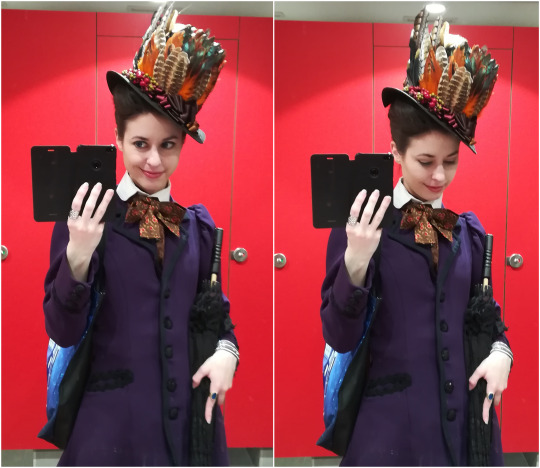
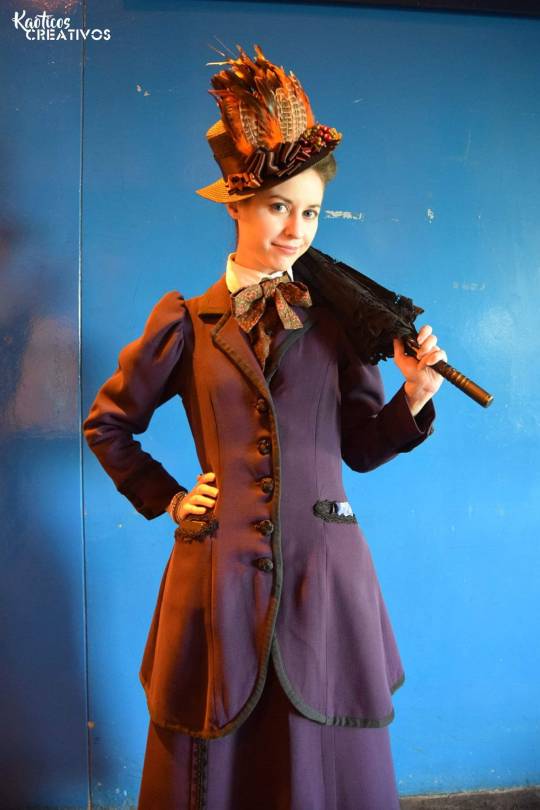
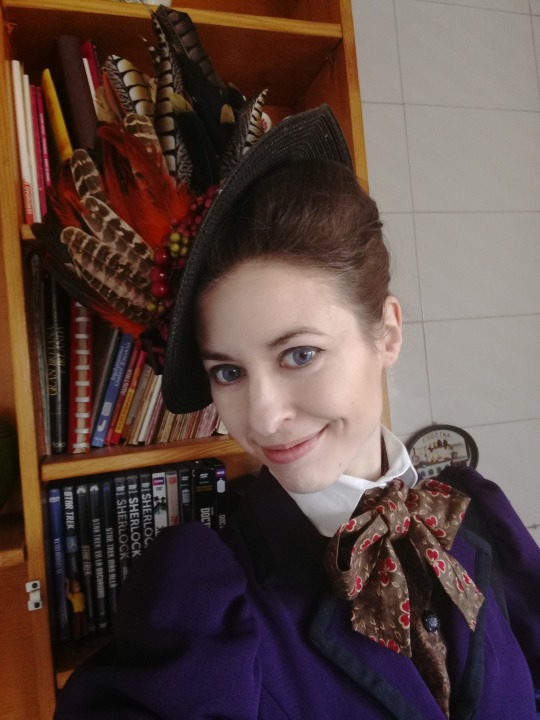


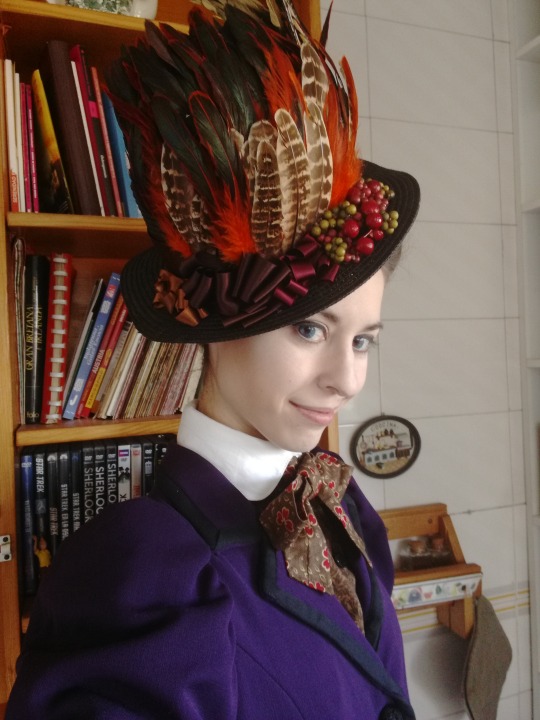




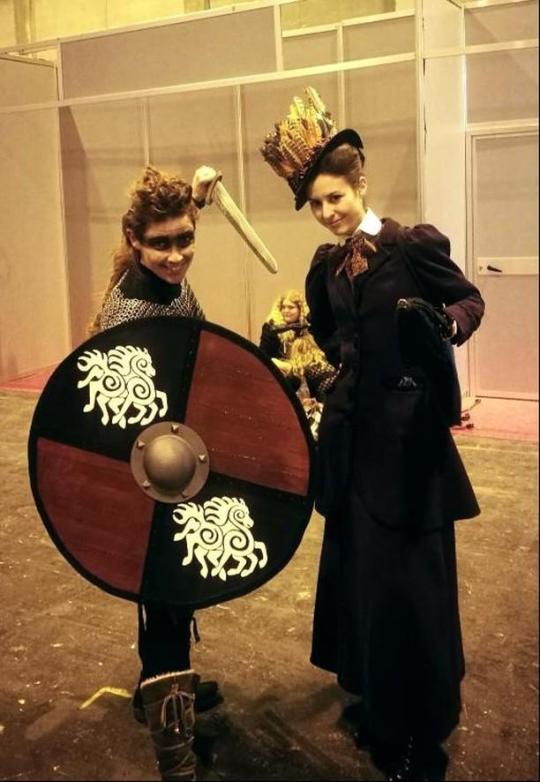
My debut of Missy's 'World Enough and Time' S10 look (with S9's hair) at a 2019 convention 😁🌂💜💜. I'm quite proud with how the feathered and majestic monstrousity that is this hat turned out xD.
Featuring TarmaErika as Twelve.
My Missy cosplay posts
DeviantArt
Facebook cosplay page
Instagram cosplay
#missy#missy doctor who#doctor who#missy cosplay#My cosplays#doctor who cosplay#whovian cosplay#12th doctor#12th doctor cosplay#michelle gomez#gomez master#the mistress#the master#elsa#elsa frozen#lagertha#world enough and time#doctor who series 10#edwardian fashion#edwardian reenactment#historical reenactment#historical costuming#missy hat#edwardian hat#peter capaldi#My historical reenactment
40 notes
·
View notes
Text


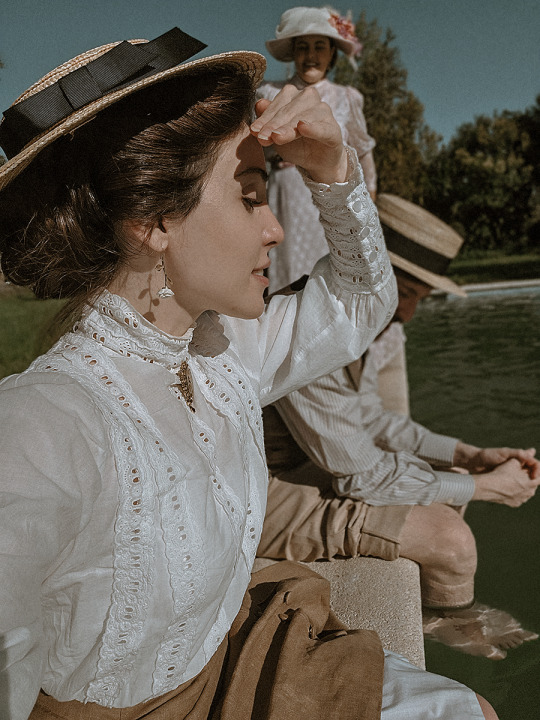

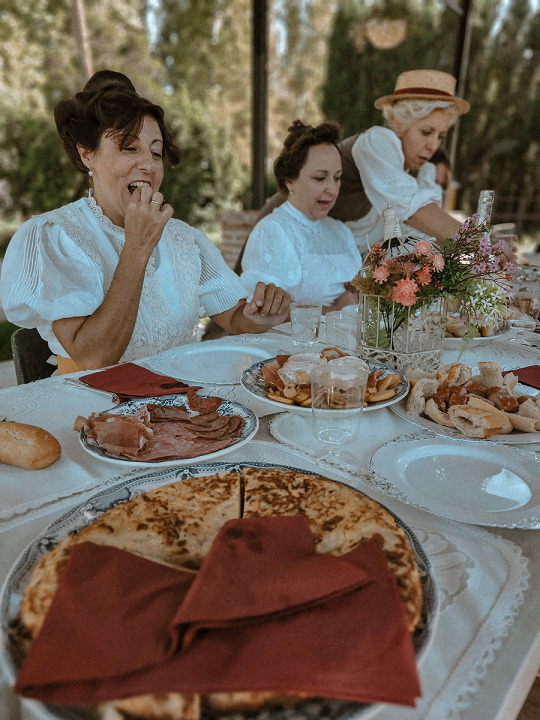

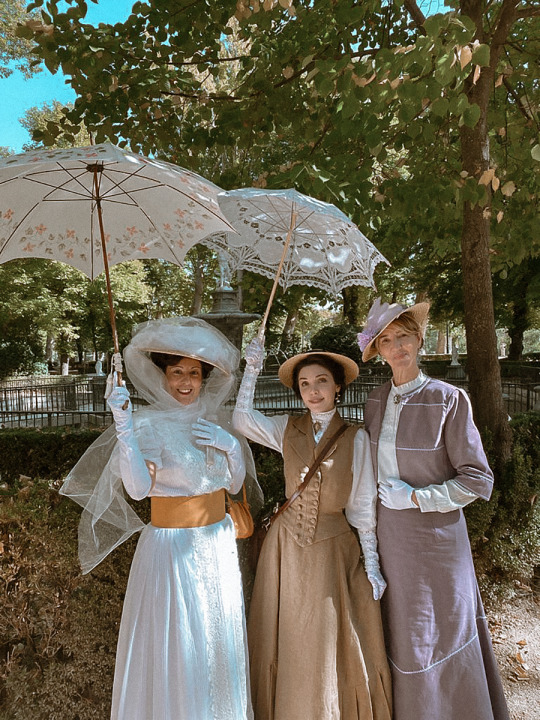


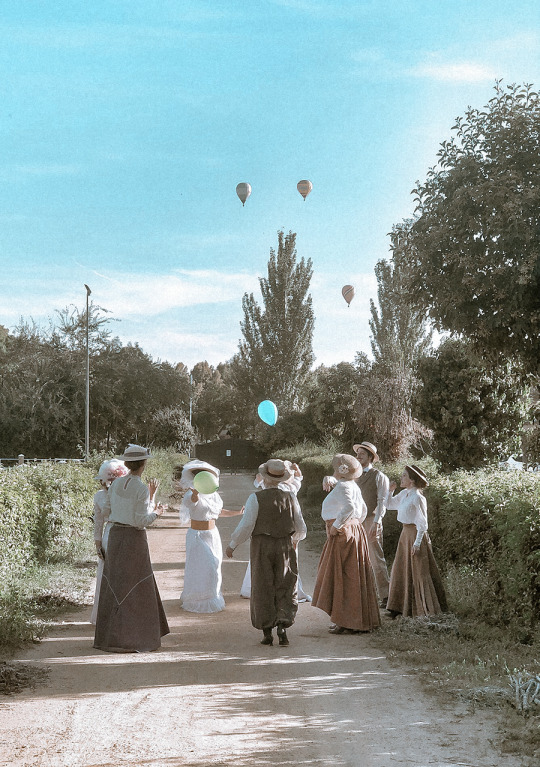
More photos from the 1900 reenactment last weekend 🥰
1K notes
·
View notes
Text
A visit to The Grand Hotel on Mackinac Island, Michigan. Gowns circa 1911, photos circa 2008.


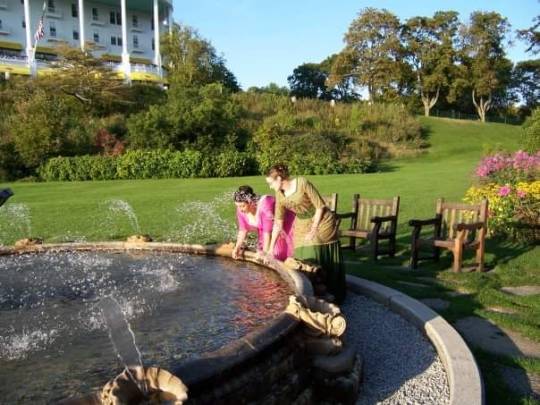



Based on gowns in the Kyoto Costume Institute, seen here:
#living history#historical costuming#history#historical reenactment#michigan#the grand hotel#mackinac island#michigan history#edwardian#edwardian fashion
51 notes
·
View notes
Photo
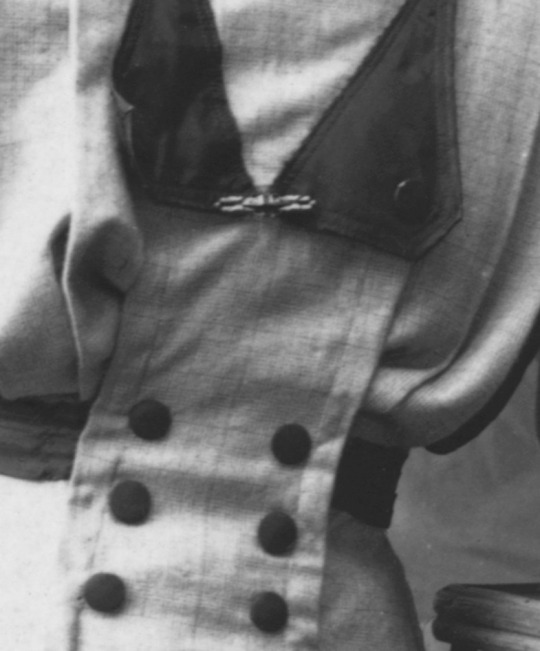
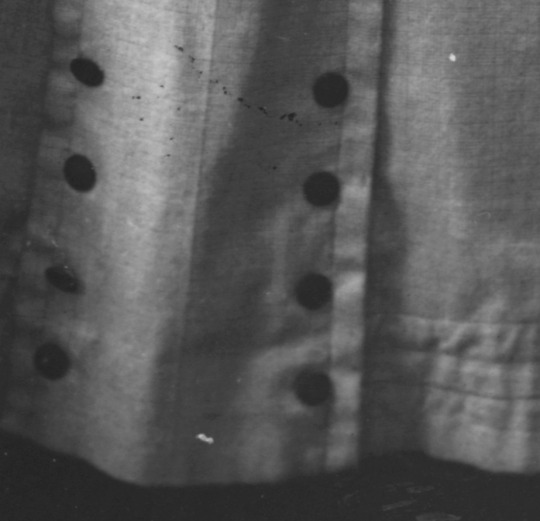

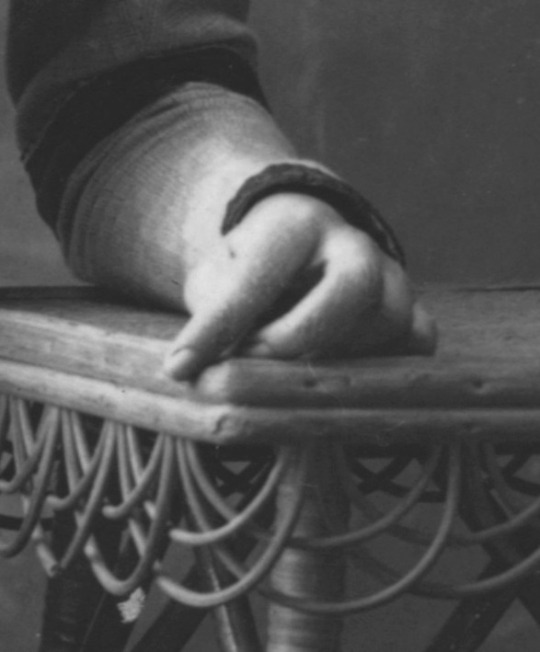


Details from portrait photograph of an unknown young woman, ca. 1900-1910.
Original photograph from our collections here: LINK
#titanic#titanic era#titanic fashion#edwardian era#edwardian fashion#edwardian dress#edwardian age#belle epoch#belle epoque#titanic 1997#womens fashion#history of fashion#fashion history#historical fashion#dress history#if you look closely you can see the fabric has a very delicate plaid pattern on it#library#queensland#reenactment#archive#queensland history#fashion archive#library aesthetic#dark academia
110 notes
·
View notes
Text

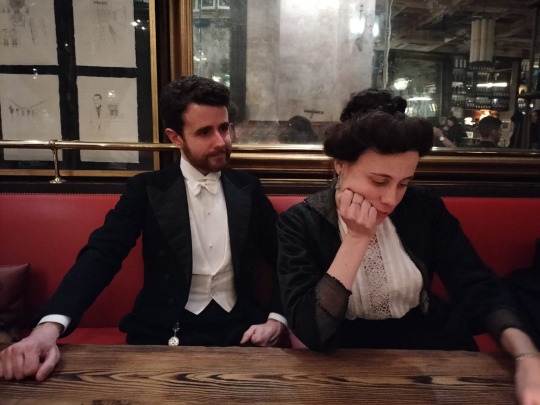
Es tiempo de glamour a lo Gibson girls con @reenactmenttime y otros nuevos amigos =)
#gibson girl#1900s#1900s fashion#white tie#gentelman#edwardian era#historical costume#historical fashion#belle epoque#reenactment#reenactor clothing
43 notes
·
View notes
Text
Everyone with even a passing interest in the historical past, please go watch Tales of the Green Valley, or of Absolute History’s “[historical period] Farm” documentary series on Youtube.
They’re video documentaries about a team of historians and archeologists living and working the day to day lives of the farming/working class in various time periods. It’s based in Britain, but the concepts they demonstrate give a good picture of daily life for most people throughout history.
#links in the reblog#prd talks#historical reenactment#tudor period#victorian era#edwardian era#high Middle Ages
9 notes
·
View notes
Text
Little subtle things that touch on racism in young royals: the 17-18th century costumes for the valentines ball. Not only are the costumes hearkening back to an exclusionary ‘golden age’ the costuming includes makeup that makes the skin appear lighter. We see at least Wille and Maddison in. Having this kind of make up is so so exclusionary - because like the wigs that Felice refuses to wear, to engage with the activity properly non-white students are being tacitly encouraged to lighten their skin and white students are being tacitly encouraged to value whiteness
And yes it’s a fun dress up heritage activity that includes make up for the reenactment purposes - I get that heritage is literally what I’m studying BUT one of the big discussions within the heritage field is the ongoing question of whose heritage is celebrated and why?
For example - it makes no sense for Hillerska to host a 17th Century ball, the school opened in 1901, there is no 17th century heritage of the school, it’s imagined heritage that they are utilising. If the ball was a turn of the 20th century ball (the Edwardian fashion era in English parlance) that would make sense as an engagement with the schools heritage. This heritage may still be racially charged but not as racially charged as the imagined 17th Century heritage ball.
So why 17th C? Well I think the school is invested in training up nobility and royalty, individuals who do have heritage dating back to that period, who are likely to imagine that period as the golden era before the class system began to be (slightly) more equal. Hillerska despite having none of its own 17th C heritage is imagining heritage for its students to help maintain an increasingly shaky class and racial system that has it’s students at the top.
It’s therefore pretty significant that Simon is not in a 17th C costume. He has no 17th C noble heritage and unlike Sara (and Alexander, and Nils) is not interested in pretending that he does.
It is also interesting that Felice, who is on a journey of self acceptance and identity beyond her social climbing white family, only partially dresses in the pretence of 17th C noble glory.
Finally, it is interesting that Wille, desperately does not want to put this costume on, and is crying as he does so. He does not want this awful legacy, it keeps him from Simon and it makes him transform himself into something he doesn’t want to be.
#young royals#the show is about the class system#the show is about power#there is also a sprinkling of racial commentary#that I for one hope they increase#young royals analysis#this sprang to life as I was writing it#because I notice that Maddison had the white powder make up on and had a brainwave#Wilhelm#Simon#Felice#Sara
176 notes
·
View notes
Note
12, 23, 24 for the history ask?
12. Would you take part in reenactment? In what era and as whom?
I technically already do! I do a Napoleonic light infantry. Not as any actual historical figure but I do get to keep making up the most ludicrous and wild backstory whenever I talk to the public. If I wasn’t doing this, I’d want to do Napoleonic naval (there’s literally no one I’d be suited to be) or Edwardian/WWI (again — no one specifically I could possibly pull off). Honestly, I’d love to do English civil war or Saxons because SWORDS (and no gunpowder license!). Anything with swords.
23. Favourite historical song with such reference?
I do have a few? Northwest Passage will always be a banger. Horse Soldier as well. There’s also one that was written by one of the gents in my re-enactment regiment and a sea shanty group recorded it. It’s about an actual person who was in the regiment and well, he died. It’s a ballad about him, The Ballad of Phillip Glass. It only exists on CD, nobody’s digitised it rip 13 Miles is also another one written about a specific event no one really knows about! Also, The Handsome Cabin Boy. Battlefield Dance Floor is also a BANGER. 10/10 recommend.
24. Most underrated historical figure?
Hannah Snell, lady tar. I wrote a stage play based on her! But also John Paynter. I’m honestly kicking myself because I know in two hours I’ll remember so-an-so and wish I’d remembered sooner lol
#thanks for the ask!#I’m gonna be so mad when I remember’OH why didn’t I mention [insert person]#unfortunately my range of historical interests is both wide and extremely specific
6 notes
·
View notes
Text
Only watched the few episodes of Edwardian Country House that are available on youtube, but:
There was one decision that they made that feels particularly questionable (and revealing!) and that really missed a lot in terms of the programme.
This was a historical reenactment series made in the UK 20 years ago, in which they got volunteers to live 'as' people in an Edwardian country house, one family for the rich family and the others as the servants. The scullery maids kept quitting. The main rich couple really enjoyed it, with comments like the husband saying about how he didn't have a servile nature (...) and the wife saying how there was so much inequality in the Edwardian period, but now perhaps things have gone too far the other way (...). The husband also made a point of how 'well, by Edwardian standards we're ridiculously lax employers, this is just how it was', but not when it came to being expected to eat dishes that were popular in Edwardian country houses but did not suit his own palate. Because it's one thing to treat people hierarchically and exhaust them through hard labour, but the line must be drawn before one eats cow's tongue or whatever. (I'm a picky eater, in that there's lots of stuff I can't bear, but then I'd never go on such a programme.)
At the end of it, they all went home. Only, the family went home one day and the people who had been playing the servants had to stay one more day to keep doing the jobs they had been doing and clean up the house, for it to be given back after filming. Only the people playing the servants.
Wouldn't it have been so much better, to have those who had been lording and ladying it over the house and talking about how (well) the system worked, to see a little of what it was like from the other side? Even only the glimpse that one day of it, rather than day after day for a few months, would have given them. This would have benefitted the programme, but also it would have made the whole thing seem a little less like a reinforcement of the class system, down to the fact that even the participants playing the servants were additionally exploited beyond the remits of the programme itself.
2 notes
·
View notes
Note
8 and 12 for the historical ask game please! :)
8. What is the last thing you have read/ listened/ spoke with historical reference?
I listened to some Sabaton earlier and they sing about history stuff so there’s that lol
12. Would you take part in reenactment? In what era and as whom?
I would LOVE to do a reenactment! I don’t really care which era because I would be excited to do any one of them. But anything Victorian or Edwardian would be fun! :)
Thank you so much for the ask!!!
3 notes
·
View notes
Note
I see you have miche Victorian fashion history infodump material? I would love to hear your 60 minute unprepared lecture
So i said victorian era, but like, this starts with marie antoinette, and the background for it goes back even farther, and then my examples extended into the mid edwardian era, so.
I’ve always loved fashion history, and started doing victorian reenactment in high school, so ofc i've read way too much about victorian fashion. These are my only qualifications, if an actual fashion historian finds things to correct, please do!
Tl;dr first. We can’t blame beau brummel for mens fashion being so boring, he was a sign of things to come, but he wasn’t why it happened. Instead we can blame sexism and industrialization!
So we actually have to start farther back than the victorian era. For most of european history post like, uhhhhhhh, dark ages ish? Basicly, back to when christianity really got going in europe and stopped having to deal with so many herecies. But only very quickly.
So the bible has some passages about women being chaste, and meek, and keepers at home and like, not having outer adornment, and there was this idea that a woman’s top priorities should be her children, running her household, and pleasing/taking care of her husband. NOT being fashionable (ofc she had to be pretty and fashionable enough to keep her husband happy, but that was it) so we see much simpler (at least on the surface) fashions for women.

(source)
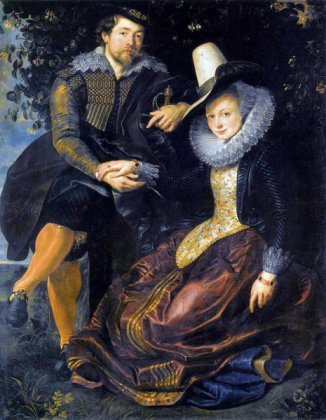
(source)
These are husbands and wives in the 1600s, and the womens clothing has less lace (ignoring the ruff, which everyone had) tends to be in colors that are easier to keep (dark reds, browns, blue) and even the pulled up gown is meant to be reminiscent of a working woman, or to suggest that this wife could, in fact, actually be involved in the practical parts of household up keep and child rearing. The men on the other hand, could definitely not work in all that finery. Natural black dies are famously unstable, the pleating, gathering, voluminous pantaloons, and abundance of lace collars and cuffs rendering his clothing utterly impractical (i love the man on the far rights sash belt that's just like, not doing anything), in addition to the wigs that were in fashion. Even the hair is more toned down on the women, styled into buns under caps, or loose curls, things that don’t take heavy ornamentation, and once again, at least look low maintenance.
Now women's fashions had moments. Particularly courtesans, which set the trends for womens fashions, but they were also improper, and so no “good” woman would want to dress like one. Until we get to the rococo period. I suspect the official mistresses of the king, madam de pompadour and the like, actually started the shift, but they walked so marie antoinette could run. She was hated, for being foreign, for spending too much money, but also for her fashion choices. A woman with hair a foot tall and such delicate painted silk dresses couldn’t even pretend to be doing work as a mother and lady of the house. She wore more jewelry too, and even her famous chemise a la rein, which looks to us very toned down and practical, was a fashion statement about her life of leisure. No one could actually work in a floofy dress of layers of thin muslin, not if she wanted it to last more than five minutes.
(obviously marie atoinette is not single handedly responsible for this shift, but she's kind of the most famous example of it, and probably did influence it quite a bit)
And so this queen, this woman who is supposed to model womanhood for her countrywoman, is more interested in fashion than running her household(/country)! The scandal! But also, if women can do fashion, then what are men supposed to do?
Well that question went unanswered for a while, while france had... 3? 4? Revolutions and the regency happened and women’s dresses are still completely impractical, especially the really narrow empire waisted ones, but we have this grecian ideal. And actually at this point mens fashion is still fairly colorful. There are some portraits with lovely butter yellow breeches and pants, green jackets over bright yellow vests and grey breeches or trousers. and there was a style of men’s breeches that where so tight it uhhhhhh. Well you remember that picture of a man in too tight skinny jeans? That. but like, men wore special under clothes to keep things from being that visible. (pinsent tailoring has a video about these and similar breeches and trousers) Still, no one could actually move or work in them. They where frequently made of kid, which is a very soft leather.
I may have thought about these breeches a lot. partly cause this style came back later.
Anyways.
Beau brummel revolutionized cravat wearing, and gave men another avenue of fashion, besides elegantly and ornately dressed man-about-court. But they deserved it, and its more fashion. Not less.
And then, end of the georgian era/being of the victorian era, we get the romantic fashions (~1830s/40s). And manmade dies. And machine woven textiles. And calico! And men seeing how many types of plaid they can fit into one outfit. Its great. Outerwear has always been toned down, and now men get these delightful smoking jacket/duster/robe things that are just, luxurious, colorful, brocade things. And fun little hats. And women get to play with bonnets and elaborate updos and poofy sleeves and skirts and. Just like, so many stripes and plaids.
This is also a good point to bring up that, at this point, and for all of history before it, all clothing was cut and stitched by hand. It might be made in a big workshop, but it was designed, cut, and tailored for you. By a dressmaker or a tailor or your mother or a servant. Off the rack clothes didn’t exist. If you were poor, you got second hand clothing and then had it tailored or tailored it yourself, or repurposed old clothing. Or you were too poor to get it tailored and made do with close enough.
Handmade clothing was actually still common up through the middle of the 20th century, especially for special occasion wear, or during hard times. But it being THE option, is about to change.
The first ever ready made clothing factory opened in 1831 in New york, but it wouldn’t take off for another 50 years. Particularly for women in their corsets, you needed to have a properly tailored dress, and so ready made just wasn’t practical. At the point you got it all tailored right, you might as well have bought the fabric and shown the picture of the dress to the dress maker. Ready made was firmly for those too poor to afford a dressmaker or tailor.
In the 1860s mens clothing really tones down. We still have interesting patterns on vests and cravats, but coats and pants increasingly only appear in neutrals, earth tones, and the like, tho they do mix these, the idea of a three piece suit in all the same color isn't here yet.
And then women’s fashion really goes crazy. We go from round skirts to ellipticals to bustles in the course of 20 years. And then there’s the brief natural form era, the second bustle period, and then a return to round skirts, and then the Edwardian era. Hairstyles change more frequently, tho they tend to pile high when there are bustles and narrow skirts, and to sit lower with hoop skirts, or the edwardian bell skirts (think gibson girls). Sleeves go from big open pagodas to tight, 3/4th length sleeves with frilly little cuffs to big poofy shoulders again.
And men, just get closer and closer to the modern suit. Part of this also has to do with the rise of office work, clerk jobs, and the middle class. At this point, secretarial duties are still the providence of men, since women aren’t supposed to go to college and work (tho women are increasingly seeking higher education, especially in the upper classes). And for this work, you need to be able to look presentable and formal on a low budget. Enter ready made mens clothing, started 50 years ago, and in particular the celluloid and paper collars and cuffs. Now, it is easier to look good in ready-made clothing if its a little blocky, or, in the case of vests, if you have tabs to adjust it. And its easier to sell if it comes in a variety of popular and easy to wear colors, like gray, brown, tan, black, navy, etc. And these are easier to coordinate if you don't try to mix and match the pieces from different sets. This, combined with the changes in men's neckwear styles, has us with bowties and a cravat that resembles our modern neckties, save a few details.
And oh look, I just described a modern suit set.
(shoes had been mass produced in standardized sizes for hundreds of years at this point, that’s a different subject and i can’t rant about it as much)
And of course, these new middle class office worker men are too serious and business minded to engage in as frivolous a pursuit as fashion. That’s the realm of women! Along with child rearing, household management, looking pretty, cooking, cleaning, uhhhhhhhh.

(source)
Also can you imagine trying to actually work in these narrow skirts? We’ve come full circle fashion wise, with women’s fashions now being obviously impractical, and mens clothing at least looking like its practical clothing he could do any work in (especially as bare shirt sleeves are now societally acceptable (this is another short rant)).
There was a brief moment of women having a similarly uniform fashion to the men’s suit in the early 1900s, as shown here, but then womens fashions moved on.
youtube
so this is my rant on fashion history, and why i'm really glad men are starting to wear colorful suits again.
#many of these dates are vague on purpose#this was fun!#i can talk about other historical fashion shit at length as well#but this is the thing i can really rant about#uhhhhhhh#yeah if something's wrong please correct me!#i'm not and expert and very much still learning!#now if only we could get men to wear those ridiculouse lacy cuffs again too
12 notes
·
View notes
Text




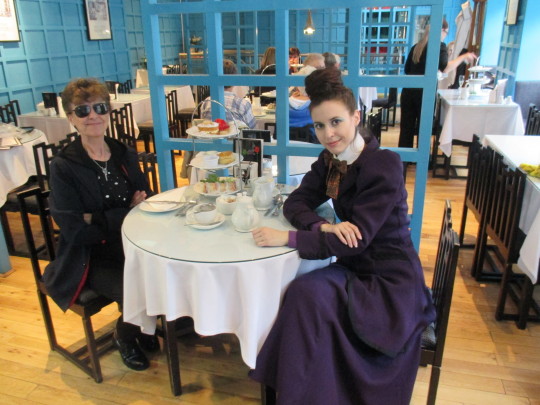
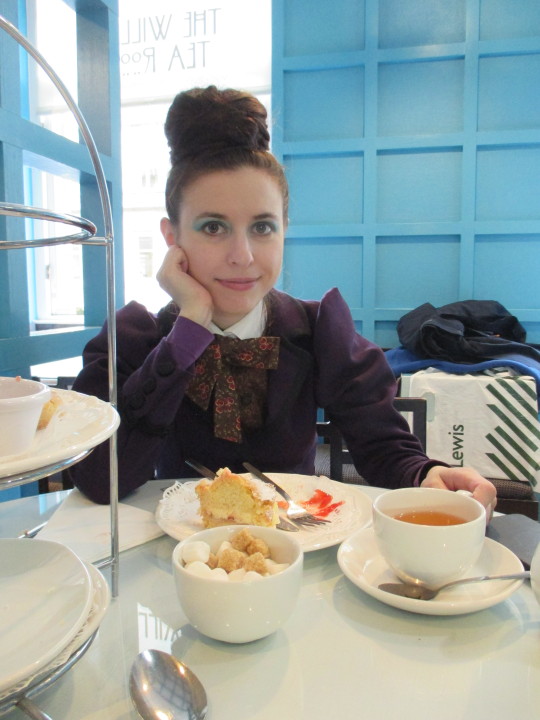

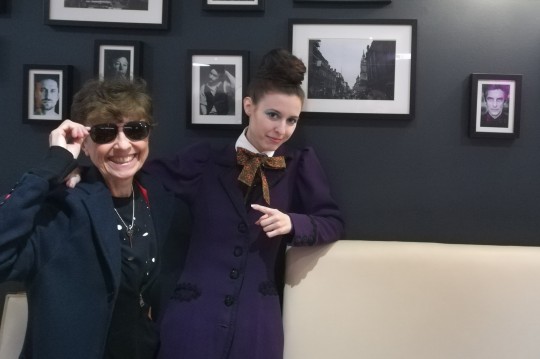
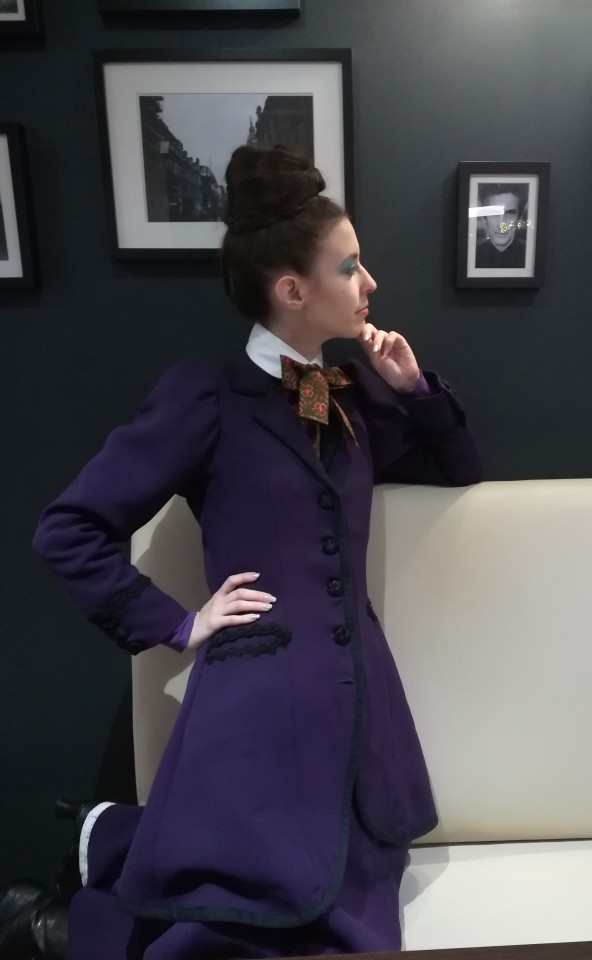

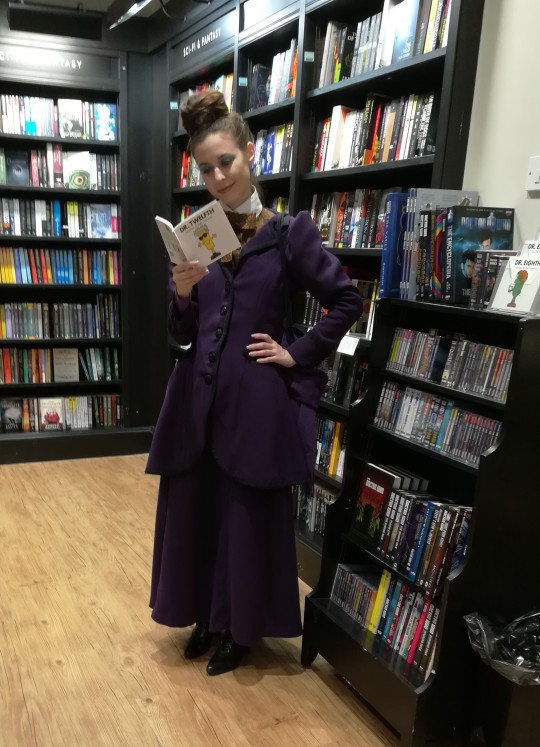

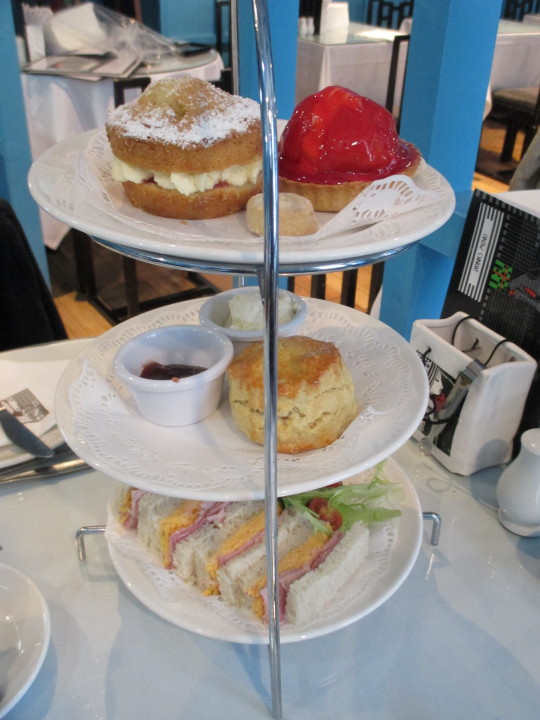
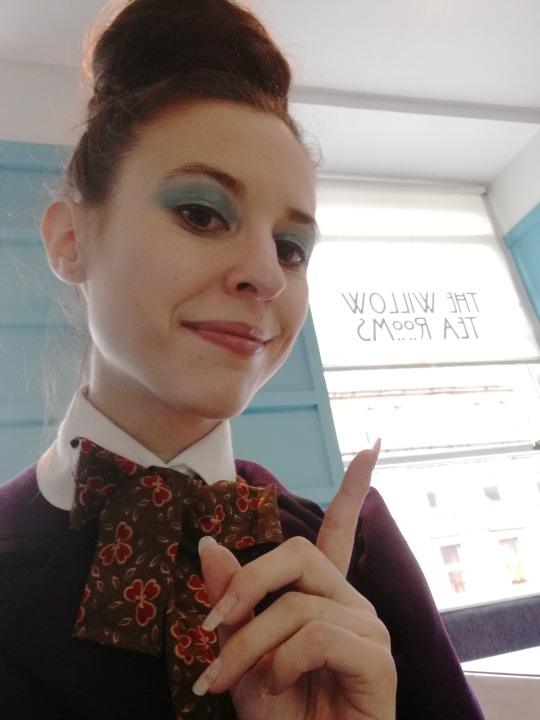



Extremis Missy (S10) ✨💜💜 in Glasgow (September 2017), featuring a portrait of Peter Capaldi at the hotel we were staying at, the scrumptious afternoon tea at Willow Tea Rooms, and DW books in Waterstones. With @tarmaerika as Twelve 😎😈💜💙
.
The Extremis Missy variation features the S9 suit with the new brown shirtwaist and ascot tie, a very high donut/sock bun (so uncomfortable on the scalp, tho, I doubt I'll do it so extreme next time I do this variation), and blue eyeshadow.
My Missy cosplay posts
DeviantArt
Facebook cosplay page
Cosplay Instagram
#extremis missy#missy doctor who#missy cosplay#doctor who cosplay#doctor who#12th doctor#twelfth doctor#12th doctor cosplay#twelfth doctor cosplay#the master#the mistress#gomez master#peter capaldi#michelle gomez#willow tea rooms#glasgow#scotland#waterstones#edwardian fashion#edwardian reenactment#1890s fashion#historical reenactment#My cosplays#My historical reenactment#extremis#series 10#best enemies#whovian#whovian cosplay#My reenactment
17 notes
·
View notes
Text






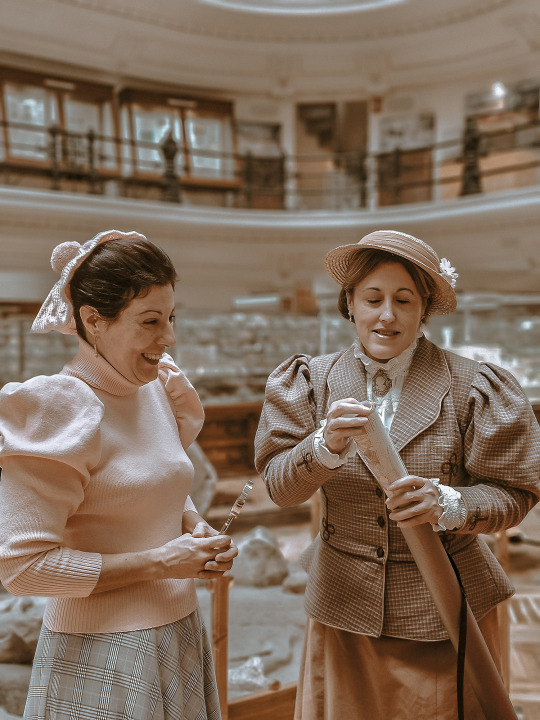

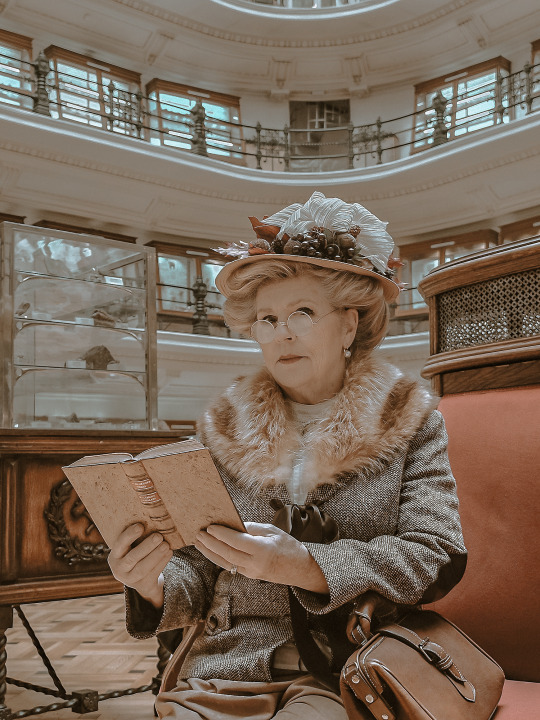


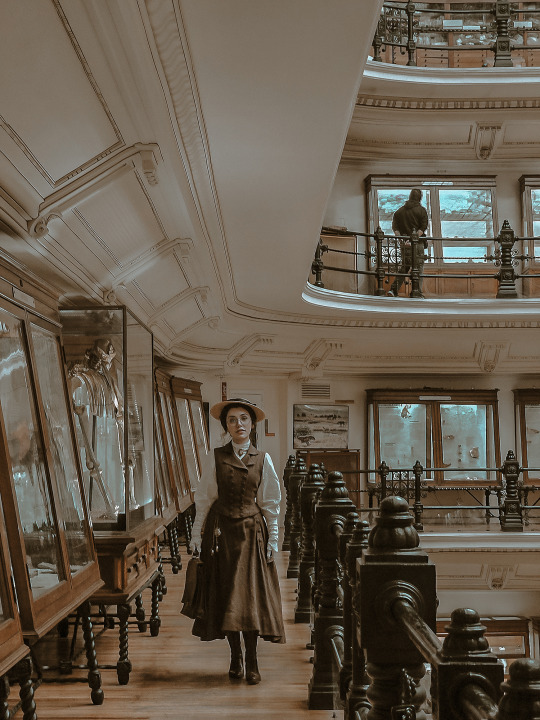



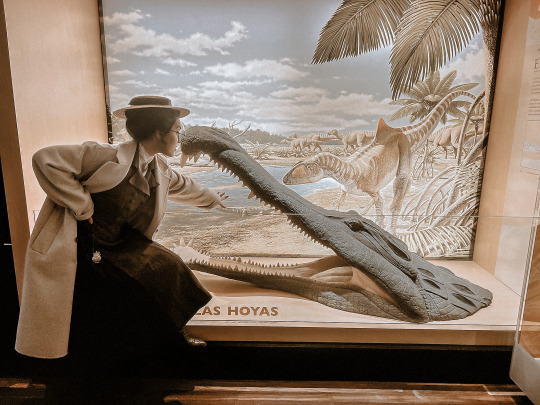







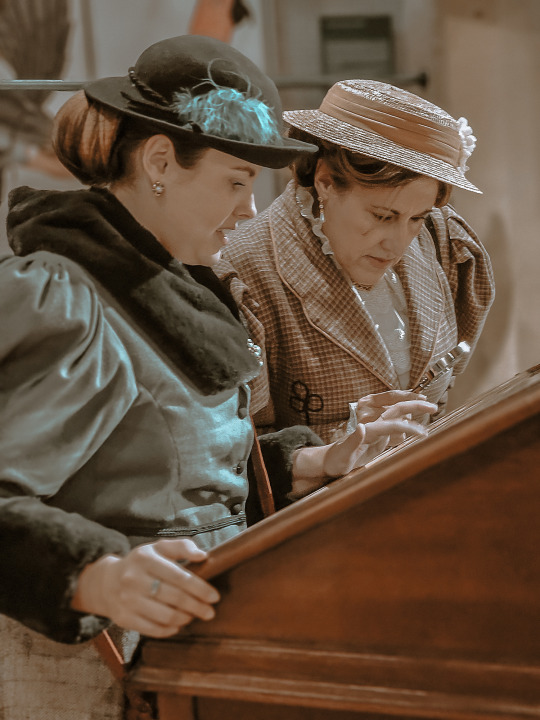




Some photos of 1900 historical reenactment we did at the Geomineral and Natural sciences museums for the International day of women in science 😊
#nips photos#historical reenactment#historical fashion#edwardian#photography#museums#personal#yes I own that waistcoat and skirt combo in three colors I love them!!#I gained 6kg since the last reenactment I can barely fit into my edwardian clothes help I can't afford new ones lmao 😩#next reenactment is set in the 20's!! I'm excited 🥰
462 notes
·
View notes
Note
Which of your guys would b most likely to enjoy or participate in historic reenactments? Like victorian or Edwardian era. Perhaps medieval. (Medieval is my favorite)
HONEY
2 notes
·
View notes
Text
Title: Exploring the Spectacular Realm of Gothic Subcultures
Introduction The Gothic subculture has captivated the imaginations of individuals worldwide, with its rich history, unique fashion choices, and diverse expressions of identity. This compelling essay aims to delve into the depths of the Gothic world, examining each type of Goth in all their intricate glory. By exploring their origins, key characteristics, and distinctive styles, we will gain a deeper understanding of the marvelous diversity within this captivating subculture.
1. Traditional Goths Traditional Goths, often referred to as "Old School" Goths, embody the essence of the Gothic subculture's inception. Inspired by the Victorian era and Romanticism, their style is characterized by dark clothing, lace, high collars, corsets, and standardized black attire. Their makeup typically includes pale complexions, dark eyeshadow, and black lipstick. Traditional Goths bear their morbid yet elegant aesthetics with pride, often emphasizing poetic and melancholic sentiments through their choice of literature and music.
2. Romantic Goths Romantic Goths embrace the romanticism of the original Gothic literature, focusing on elements of tragedy, longing, and the beauty found between light and darkness. They find inspiration in classic works such as "Frankenstein," "The Picture of Dorian Gray," and the poems of Edgar Allan Poe. Romantic Goths often adopt a more ethereal appearance, adorning themselves in flowing black garments, frills, lace, and delicate accessories. Their makeup blends dark hues with ethereal touches, reflecting their enchanting and otherworldly nature.
3. Cyber Goths Cyber Goths epitomize the fusion of Goth and futuristic elements. Drawing inspiration from science fiction and cyberpunk aesthetics, this subculture boasts vibrant neon colors, synthetic materials, and various forms of body modifications, including piercings, tattoos, and neon-colored hair. Cyber Goths often wear stompy boots, goggles, gas masks, and incorporate glow-in-the-dark accessories. Their makeup can be an artistic explosion of neon colors, unique patterns, and glowing, futuristic designs.
4. Victorian Goths Steeped in the Gothic tradition, Victorian Goths resurrect the elegance and grandeur of the Victorian and Edwardian eras. Their attire includes long coats, top hats, parasols, lace, and exquisite period-inspired clothing. They often frequent historical reenactments, vintage markets, or create their own elaborate events, immersing themselves in a bygone era. Victorian Goths apply makeup with precision, often emulating the iconic Victorian aesthetic, featuring pale complexions, rosy cheeks, and natural tones.
5. Nu-Goths Nu-Goths emerged more recently, incorporating modern elements into the traditional Gothic style. They often blend Goth aesthetics with modern fashion trends such as graphic t-shirts, sportswear, and streetwear influences. Nu-Goths may sport black skinny jeans, combat boots, chokers, and leather jackets. Their makeup style often embraces bold, striking features, using dark lips, strong eyebrows, and creative eye makeup to make a statement.
Conclusion The Gothic subculture thrives on a breathtaking tapestry of expressions, encompassing diverse types from traditional and romantic to cyber and Victorian Goths. Each type brings a unique interpretation of Goth culture to life, reflecting their individual perspectives, inspirations, and artistic choices. By understanding and appreciating the intricate details of every type of Goth, we can celebrate the profound impact they have on art, fashion, music, and literature, ensuring the Gothic subculture continues to mesmerize generations to come.
#gothculture #viral #subscribe #vampiregoth #GothicFame
0 notes
Text
Famous Classy Vintage Corsets
Vintage corsets are iconic pieces of lingerie and fashion history that have made a remarkable resurgence in recent years. These corsets draw inspiration from past eras, typically reflecting the Victorian and Edwardian styles of the late 19th and early 20th centuries.
They exude an air of elegance, femininity, and sensuality.
Constructed from a variety of materials, vintage corsets often feature intricate lace, delicate embroidery, and boning to create a structured yet graceful silhouette. They are typically designed as overbust or underbust, allowing for versatility in outfit pairing.
While some vintage corsets are authentic antique pieces, many are modern recreations that incorporate modern fabrics and construction techniques for enhanced comfort. They have gained popularity not only as lingerie but also as statement pieces for outerwear, often seen at historical reenactments, themed parties, and various fashion events.
Vintage corsets continue to captivate fashion enthusiasts, serving as a bridge between the elegance of the past and the timeless allure of the present. Their enduring appeal showcases the everlasting beauty of vintage aesthetics.
0 notes